In Europe, four types of currants are commonly cultivated (white, black, yellow, and red). Although they differ in berry color, taste, and aroma, the plants are low-maintenance and have similar care requirements. They are susceptible to the same diseases and pests.
Infections and insects are the primary causes of death for fruit-bearing shrubs. Even disease-resistant varieties can be affected under certain conditions. Without timely treatment, not only the infected plant but also nearby crops may perish. To save your garden, it's crucial to recognize diseases and pests early and know how to combat them.
Table of contents
Diseases and Their Treatment
A healthy currant plant has many vibrant green leaves of the correct shape, produces abundant yields of round berries with rich flavor, and easily withstands winter. An infected plant loses frost resistance, yields poorly, and sheds foliage. Photosynthesis deteriorates, eventually leading to the plant's death.
Many diseases can be effectively treated in early stages. Later, combating them becomes more challenging. Therefore, early detection is essential. European gardeners should be alert to the following signs:
- Suspicious spots on leaves;
- Powdery coating on foliage, fruits, and shoots;
- Yellowing leaves and premature leaf drop;
- Shriveled bushes;
- Fruit drop;
- Raised growths.
To determine why currants are ailing and what to do, compare symptoms with known disease indicators.
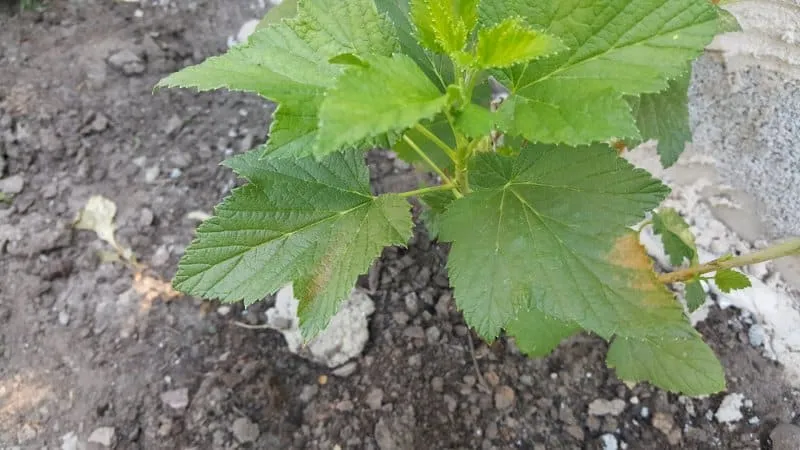
Tubercularia Canker
Tubercularia canker – a fungal disease that causes branch and leaf desiccation. High humidity and mechanical damage to bushes contribute to its development.
Symptoms include:
- Red nodules form on young shoots;
- The infection spreads to other branches, penetrating bark and forming red swellings;
- By July, leaves dry, curl, and fall;
- Affected branches die.
To eliminate tubercularia canker, remove infected branches. Dust cuts with ash and apply grafting wax. Spray the bush with copper-based fungicides.
Anthracnose
Anthracnose – a fungal disease. Plants contract it in spring, but symptoms appear 1.5–2 months later, typically peaking in July.
Infected plants rapidly lose leaves and fruit. Winter hardiness decreases, photosynthesis weakens.
Note! The fungus survives freezing temperatures, overwintering in plant debris. It activates during prolonged rains, excessive watering, or when weeds surround currants.
Anthracnose symptoms:
- Red or brown spots appear on leaves, later forming blisters;
- Affected areas expand, merging into large burgundy swellings;
- Leaves dry and fall.
Treatment is easiest in early stages. Remove all infected foliage. Spray healthy leaves with:
- Bordeaux mixture (100g per 10L water).
- Home remedies: dissolve 1kg wood ash and one bar of laundry soap in 10L water.
- Chemical fungicides if other methods fail. Effective options include "Teldor" (2 tablets per 1L water).
Apply treatments weekly during dry weather.
All currant varieties can contract anthracnose, but red currants are most vulnerable.
Septoria Leaf Spot
Septoria leaf spot (white spot disease) primarily affects black currants but infects other plants too. Summer-active fungi cause it.
Overcrowded plantings, high humidity, insufficient sunlight, and poor air circulation promote development.
Identifying white spot disease:
- Angular brown spots (2-3mm diameter) appear on leaves;
- Spots whiten with dark borders;
- Disease spreads to berries;
- Infected leaves and fruit drop.
Before treatment, remove affected plant parts and thoroughly weed. Burn all collected vegetation.
Effective septoria treatments:
- Bordeaux mixture (100g per 10L water);
- Fungicides: Folpet, "Cuprozan", "Captan".
Sclerotinia Rot
Sclerotinia rot (white mold) – a fungal infection affecting all plant parts, eventually killing bushes. The soil-dwelling fungus activates during high humidity and plant stress.
White mold symptoms:
- Brown, weeping lesions form at shoot bases;
- Leaves wilt;
- Infected areas rot, developing cottony white mold;
- Plant parts above infections die.
At first signs, remove infected parts, treat cuts with grafting wax. Spray entire shrubs with fungicides. If symptoms reappear, dig up and burn affected plants.
Note! Failure to remove sick plants spreads infection to neighboring shrubs.
Powdery Mildew
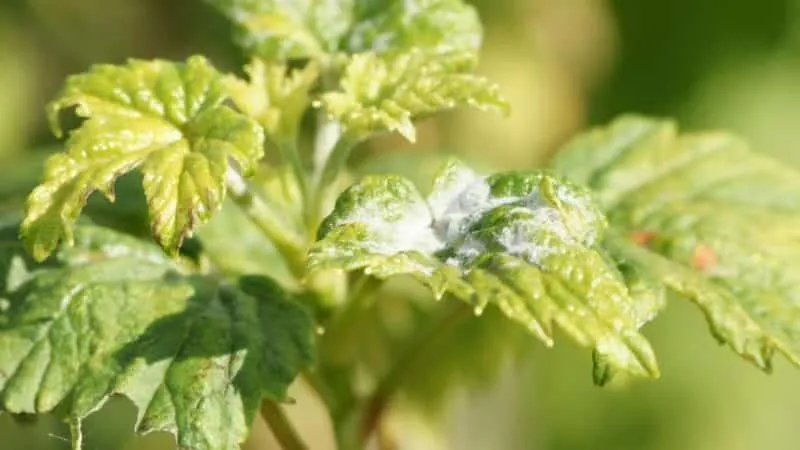
Powdery mildew – another fungal disease. Fungus peaks in mid-summer.
This dangerous infection affects all plant parts, causing leaf/fruit drop and shoot desiccation. Impaired photosynthesis reduces winter survival chances. Within years, growth stops completely and plants die.
Causes include dry soil, high humidity, nitrogen-rich soil. Infection spreads through soil, contaminated planting material, and weeds.
Powdery mildew signs:
- Dry, translucent white coating on leaves/shoots;
- Coating thickens, turns brown, feels like felt;
- Infected shoots deform, stop growing, die;
- Berries develop coating, darken, drop prematurely.
Early treatment reduces need for harsh chemicals. Before spraying, remove all diseased parts.
Treatment options:
- Copper-based products. Spray with Bordeaux mixture or copper sulfate.
- Home remedy: Mix 1 bottle 5% iodine with 2L milk in 10L water. Treat plants twice, 4 days apart.
- Bacterial method: Dilute chicken manure 1:10 with water. Spray bushes.
- Commercial fungicides: If other methods fail, use "Topas" or "Folicur". Berries become inedible after treatment.
Rust
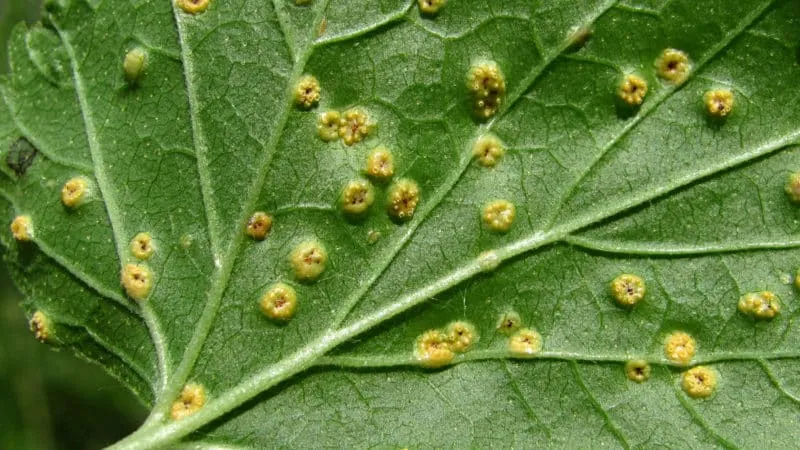
Rust pathogens – fungi. Plants typically contract infections mid-summer or autumn, resulting in leaf and berry drop.
Note! Spores spread via sedges, conifers, and weeds.
Two rust types affect currants – goblet and columnar. Goblet rust symptoms:
- Orange spots appear on leaf undersides;
- Spots become yellow spore-filled blisters;
- Affected areas enlarge, causing entire leaves to dry;
- Leaves and berries fall.
Columnar rust is equally dangerous. Its manifestations:
- Leaf tops develop small yellow dots;
- Undersides grow orange spore pustules;
- Pustules become hairy, leaves feel like felt.
Before treatment, remove infected leaves. Apply:
- Biological fungicide "Fitosporin";
- Bordeaux mixture diluted 1:100 with water.
Striped Mosaic
Currant mosaic – a viral disease causing leaf desiccation/drop and eventual bush death.
Primary symptoms:
- Yellow-orange areas appear on leaves;
- Affected zones dry out, spreading across surfaces;
- Leaves fall.
Mosaic is incurable. Remove infected plants immediately. For prevention, spray bushes with insecticides – aphids and mites transmit the virus.
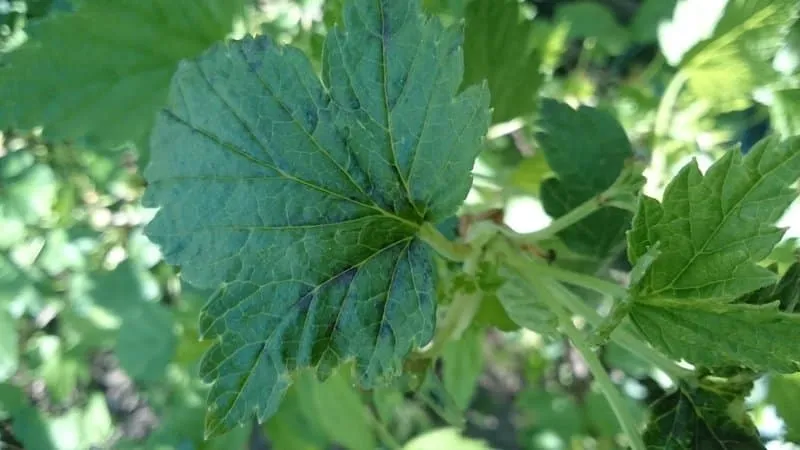
Leaf Curl
Leaf curl results from viral or fungal infections, both spread by aphids. Symptoms are identical:
- Leaves develop uneven thickness;
- Leaf blades curl, blister, and redden;
- Leaves dry and fall.
For treatment, first eliminate aphids and remove damaged leaves. Then spray with Bordeaux mixture.
Nectria Shoot Blight
Nectria shoot blight affects only red and white currants. The sac fungus causes it, leading to young shoot dieback and eventual plant death.
Symptom description:
- Orange dots appear on young shoots;
- Dots enlarge, appearing swollen;
- As spores mature, formations blacken;
- Young shoots die.
For control, remove all infected branches. Treat cuts with grafting wax, spray plants with Bordeaux mixture.
Reversion Disease
Reversion disease (blackcurrant gall mite) – a viral condition spread by mites. Causes plant mutation and sterility.
Reversion signs:
- Leaves elongate, become asymmetrical and smooth;
- Leaf lobes reduce from five to three;
- Foliage turns purple;
- Flowers lengthen and thin;
- Plants lose characteristic aroma;
- Fruit production ceases.
The disease is untreatable. Remove and burn infected bushes. Maintain 5-year quarantine on affected land.
Chlorosis
Chlorosis – a condition from reduced photosynthesis and chlorophyll deficiency. Caused by nutrient deficits and poor weather. Symptoms include:
- Pale, yellowish foliage;
- Premature leaf drop;
- Stunted shoots;
- Root death.
Apply complete mineral fertilizer and adjust care regimen to correct.
Necrosis
Marginal necrosis results from soil chlorine excess. Leaf edges dry out, turning ashy gray.
At necrosis signs, apply ammonium nitrate before and after flowering.
Pests and Control Methods
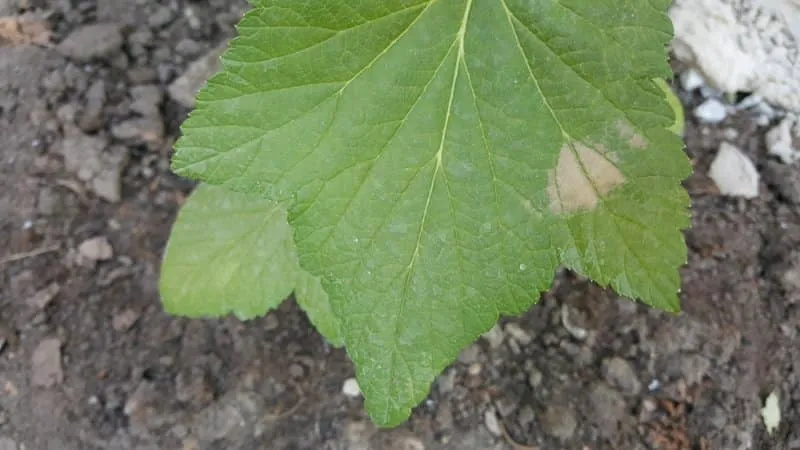
Pests threaten currants as severely as diseases. They feed on sap, leaves, and fruit, killing shrubs. Insects often transmit viruses and fungi.
Common currant pests:
- Bud Mite. Inhabits plant buds, feeding on them. Infested buds appear swollen and rounded. Next year, they produce small, thin, misshapen leaves. Remove/burn affected parts. Spray with sulfur-based miticides.
- Spider Mite. Tiny light-colored insects suck plant juices, webbing leaf undersides. Causes premature leaf death/drop. Combat with miticides or home remedies like wormwood decoction with laundry soap. Spray until resolved.
- Sawfly. Larvae devour leaf tissue, leaving only veins. Resembles green caterpillar with black head/spots, 10 leg pairs. Overwinters in glossy brown underground cocoons, emerging as egg-laying butterflies in spring. Hatched larvae defoliate plants. Cycle repeats. Control by shaking larvae onto ground sheets. If ineffective, use insecticides ("Spruzit").
- Gooseberry Moth – butterfly whose caterpillars eat berries. Green pests with black legs/head/stripes web over flower clusters, then consume berries, causing premature ripening/drying. Remove nests. Spray with "Calypso" before flowering.
- Geometer Moth. Another butterfly whose larvae skeletonize leaves. Shake pests onto sheets beneath plants. Use insecticides if necessary.
- Currant Borer. Wasp-like insect with thickened abdomen tip. Lays eggs under bark. Larvae tunnel branches, causing dieback. Remove infected wood, seal cuts with wax. Apply insecticides.
- Aphids. Tiny black insects suck shoot/leaf sap. Causes premature leaf drop, stunted growth, plant death. Spray with onion/garlic infusion containing laundry soap.
- Metallic Beetle. Shiny beetles inhabit/eat shoots. Infested branches die. Remove affected parts, apply insecticides.
- Currant Clearwing. Caterpillars eat buds, become egg-laying butterflies. Larvae hollow out fruits. Overwinters under loose bark. Use insecticides.
- Scale Insects. Mobile young settle on plants, developing protective scales where they remain, reproducing. Feed on sap, gradually killing branches/bushes. Spray with "Mospilan".
Disease and Pest Prevention
Combating insects, treating diseases, and subsequent care challenge novice gardeners. Prevention proves simpler:
- Proper care (watering, aerating, mulching) forms prevention's foundation. Improper irrigation and lack of aeration primarily cause fungal infections.
- Always remove old/diseased branches.
- After snowmelt, experienced gardeners "scald" currants – pouring boiling water over bushes and surrounding soil.
- Clear/burn autumn leaf litter around plants. Weed regularly during growth.
- In spring, treat currants, gooseberries, and other berry shrubs with copper sulfate.
- Select varieties resistant to viruses/fungi when possible.
- Avoid overcrowding when planting.
- Disinfect soil, planting material, and tools.
Conclusion
Diseases and pests commonly cause currant death. They attack all plant parts, causing leaf/berry drop and shoot dieback. Timely symptom recognition and proper treatment can save plants. Recovered specimens require extended rehabilitation with intensive care, making prevention preferable to cure.







